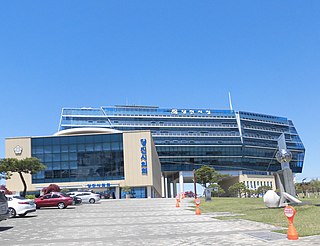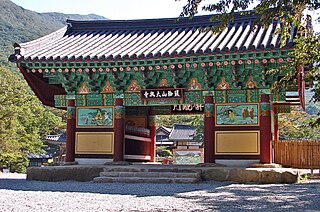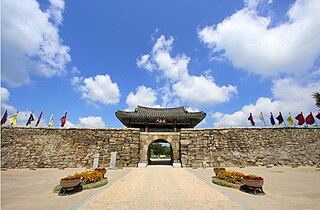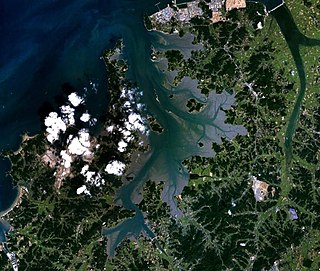External links
- Seosan Athletic Association Center (in Korean)
- World Stadiums
Seosan City Stadium is a multi-use stadium in Seosan, South Korea. It is currently used mostly for football matches and is the home stadium of Seosan Citizen. The stadium has a capacity of 10,000 people and opened in 2001.

The Seoul World Cup Stadium (Korean: 서울월드컵경기장), also known as Sangam Stadium, is a stadium used mostly for association football matches. The venue is located in 240, World Cup-ro, Mapo-gu, Seoul, South Korea. It was built for the 2002 FIFA World Cup and opened on November 10, 2001. It is currently the second largest stadium in South Korea after Seoul Olympic Stadium, and is the 2nd largest rectangular stadium in Asia. It was designed to represent the image of a traditional Korean kite. The stadium has a capacity of 66,704 seats, including 816 seats for VIP, 754 seats for press and 75 private Sky Box rooms, each with a capacity for 12 to 29 persons. Due to table seats installation, capacity was reduced from 66,806 seats to 66,704 seats in February 2014. Since the World Cup it has been managed by the Seoul Metropolitan Facilities Management Corporation (SMFMC). FC Seoul moved to the Seoul World Cup Stadium in 2004.

Seosan is a city in South Chungcheong Province, South Korea, with a population of roughly 175,000 according to the 2017 census. Located at the northwestern end of South Chungcheong Province, it is bounded by Dangjin, Naepo New Town, Yesan-gun and Hongseong-gun on the east, Taean-gun and the Yellow Sea on the west, 125 km (78 mi) south of Seoul, 159 km (99 mi) northwest of Daejeon and 34 km (21 mi) northwest of Naepo New Town. Seosan is the hub of transportation on the west coast where the Seohaean Expressway, Daejeon-Dangjin Expressway, and National Highways No. 29, 32, 38, and 45 intersect.

Dangjin is a city in South Chungcheong Province, South Korea. It stands on the south shore of the Bay of Asan. Dangjin borders Incheon, Pyeongtaek, and Hwaseong by sea, and Seosan, Yesan, and Asan by land. Its name means "Tang ferry," and refers to the historic role of Dangjin's harbor in connecting Korea to the other side of the Yellow Sea. This role continues to be important in the city's economy, which relies on a mixture of agriculture and heavy industry. The city has the same Hanja name (唐津市) as Karatsu in Saga Prefecture, Japan.

Goyang Stadium is a multi-purpose stadium in Goyang, South Korea used mostly for football matches and was the home ground of Goyang Zaicro FC of the K League Challenge from 2013-16. The seating capacity is 41,311 and construction was completed in 2003. It is occasionally used for matches of the South Korea national football team.

The Jeju Stadium is a multi-purpose stadium in Jeju City, Jeju Province, South Korea. It is currently used mostly for football matches. The stadium was used by K League team Jeju United between 2007 and 2010. The stadium has a capacity of 20,053 people and was opened in 1968. The stadium was used for 2017 AFC Champions League round of 16 1st leg match against Urawa Red Diamonds since their regular stadium was used for 2017 FIFA U-20 World Cup.

Daeheungsa (Korean: 대흥사), sometimes called Daedunsa, is a main temple of the Jogye Order of Korean Buddhism. Daeheungsa is located on the slopes of Duryunsan in Samsan township, Haenam County, South Jeolla Province, South Korea.

Ansan Wa~ Stadium is a multi-purpose stadium in Ansan, Gyeonggi Province, South Korea. It's currently served as home stadium for Ansan Greeners FC. The stadium was opened in 2007 and has a capacity of 35,000 people. It is used mostly for football matches and athletics. It is located next to Gojan Station on Seoul Subway Line 4.

Hyochang Stadium is a multi-purpose stadium in Hyochang-dong, Yongsan District, Seoul, South Korea. It is currently used mostly for football matches. The stadium has a capacity of 15,194 people. It was built in October 1960 for the 1960 AFC Asian Cup.
Paju Stadium is a multi-use stadium in Paju, South Korea. It is currently used mostly for football matches. The stadium holds 22,000 people and opened in 2001.

Yesan Football Club is a South Korean soccer club based in Yesan county.

Anyang Sports Complex is a group of sports facilities in Anyang, Gyeonggi, South Korea. The complex consists of Anyang Stadium, Anyang Gymnasium, a swimming pool, an ice rink, a tennis court, and an auxiliary stadium.

The Mokdong Stadium is a South Korean sports complex located in Mok-dong, Yangcheon-gu, Seoul. It consists of a multi-purpose stadium, a baseball stadium, and an artificial ice rink. It was opened on 14 November 1989. The main stadium hosted K League football matches from 1996 to 2001.

Haemieupseong (Korean: 해미읍성) is a fortress located in Haemi-eup near Seosan, South Chungcheong Province, South Korea. Haemi Castle was built between the 17th year of the reign of King Taejong (1417) and the 3rd year of Sejong the Great's reign in 1421 during the Joseon period. The fortress was completed in the 22nd year of the reign of King Seongjong. In January 1963, it was listed as South Korea's Historical Site No. 116 and was renovated in 1973. The castle was the background of the Donghak Rebellion in 1864. This fortress, originally built to protect against Japanese pirates, was a historical site where thousands of Catholics were executed during the French Invasion in 1866.

Garorim Bay Tidal Power Station is a planned tidal power plant in Garorim Bay, on the west coast of South Korea. The project is developed by Korea Western Power Company Limited and was in the process of receiving government approval as of November 2008.

The Incheon Stadium, commonly known as the Incheon Asiad Main Stadium, is a stadium located in Incheon, South Korea. Completed in July 2014, it is used mostly for athletics and was the main venue of the 2014 Asian Games. The stadium has been designed with an initial capacity of roughly 60,000 spectators. After the 2014 Asian Games, capacity was reduced to 30,000 spectators. The stadium has an oval running track enclosing a regulation-size soccer field. Outside, there's a tennis court, a subsidiary stadium, and the 1,415.13 m2 Yeonhui Cricket Ground.
Jeonnam Stadium (Korean: 전남야구장) is a stadium in Hampyeong, South Korea. Kia Tigers, the home stadium of the two groups had been used in 2006–11.

The Rock-carved triad buddha in Seosan is located at Gayasan, Unsan-myeon, Seosan, South Chungcheong Province. The Standing Buddha Reborn was sculptured in the center which is 208 centimeter high, with a standing image of a bodhisattva on his right side and an image of the Bangasayusang on his left side. It is also known as "the smile of the Baekje", and it is considered to be a notable example of Buddhist images carved on rock cliffs and which were made by digging into the natural rocks and sculpting the statue.
Hanseo University (Korean: 한서대학교) is a private university located in Seosan and Taean, South Korea. The university was established in 1991 and provides courses in a wide range of liberal arts, engineering and design disciplines.
Chulpo-ri is a village in Daehoji County, Dangjin City, Chungcheongnam-do, South Korea. It was originally under the jurisdiction of the neighbouring Haemi County, Seosan City, but was reassigned to Daehoji County in 1957.